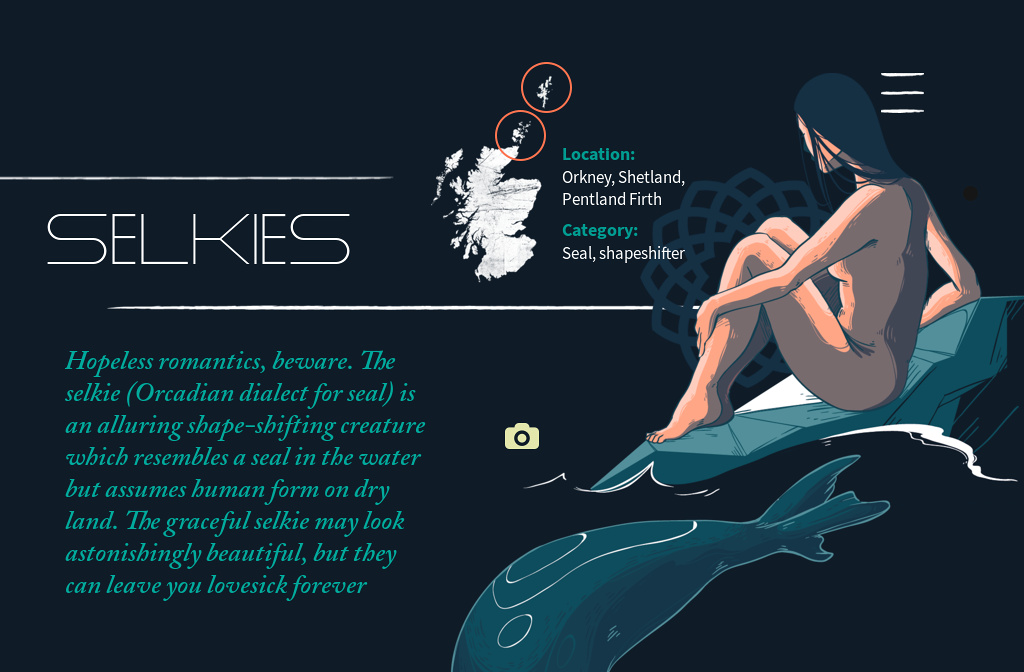I first heard this ancient tale in song; I used to sing and play it on my guitar. The vivid story concerns a mighty male selkie, surely a selkie king, maybe even the High King of all the Selkie race, who had a fascination with human women, as do all male selkies. But, Selkies were not rapists. They were romancers, very charming and extremely handsome in their human forms.
It was rumored that if a lonely woman cried seven tears into the sea on a full moon night a selkie would come to her. That is just what the woman in this song did. And, the Great Selkie Of Sule Skerry swam the foam of the sea, changed on the beach from a magnificent seal to a stunning dark haired, dark eyed man and came to her bedside.
He spoke few words; he didn’t have to for he was irresistible. (Of course, he was cloaked in a powerful spell.) After he made tender, yet passionate love to her he told her she would bear him a son, that she would care for the half-selkie boy for seven years. Then, in seven years he would return, bringing with him a purse filled with gold. This he’d give to the woman to pay her for care of their child.
When the woman finds she’s with child by the majestic selkie he shows characteristic faerie nonchalance and callousness about her pregnancy. Then, the woman remembered that the selkie wanted the baby. She began to weep, to protest, to beg and beg the selkie not to take to boy from her, but it was no use. The selkie was absolutely adamant.
And, true to his promise he returned, seven years to the day the boy was born. Before he left with the child the selkie made a very dire prediction. He had seen death clearly. He told the woman she would marry a gunner, a very fine gunner of a whaling ship, and that not long after the wedding the gunner would kill him and the half-selkie child.
And so, only a couple of weeks after their wedding the husband heard his wife sobbing bitterly, missing her son. He made his wife tell about her affair with the Great Selkie Of Sule Skerry and the birth of the half-selkie baby. The husband became filled with jealous rage, as if a poisonous canker was growing inside him. He became obsessed with the thought of killing the selkie, who he considered to be violator of his wife, and also of killing their bastard half human offspring.
One day, he saw a pair of abnormally large seals playing on the beach, their sleek coats shining in the sunlight. The husband immediately sensed it was the Great Selkie and the half-selkie child. He crept behind a big rock, took careful aim with his harpoon, and with a single powerful throw speared the Selkie’s heart and the heart of his son, as he clasped him gently to his chest with his large flippers.
The Great Selkie cried out in human language, --- “My son, my son, we are killed!,” and they died. Their bodies were taken by the next wave. For all selkies must return in some way to the sea that spawned their race.
The Scottish dialect words are:
Ane = one
Aught = make
Ba lilly wean = my lovely child
Bairn = child
Bed firt = foot of the bed
Faeme = foam
Frae = from
Grumy = troubled
Hae = have
Ken = know
Norris = nurse
Quo = quote
Staps = stops or dwells
Weel = well
********
“An earthy norris sits and sings,
And, aye, she sings, ‘Ba lilly wean...
‘T is little I ken my bairn’s father,
Far less the land that he staps in!”
For ane night he arose to her bed fit,
And, a grumy guest, aye, was he,
Saying, ‘Here am I, thy bairn’s father,
Although I be not comely.’
‘I am a man upon dry land;
I am a silkie in the sea.
And, when I’m far frae every strand,
My home it is on Sule Skerry.’
‘And, thou will norris my wee young son
For seven long years upon thy knee
And, at the end o’ seven long years
I’ll come and pay thy norris’ fee.’
‘T was weel eno’ the night we met
When I’d be oot and on my way,
Ye held me close; ye held me tight, saying, ---
Just ane mair time ere break o’ day!’
‘It was weel,’ the maiden cried,
It was weel, indeed, quo she,
For the Great Silkie Of Sule Skerry,
To hae come and aught a bairn on me!’
Then, he has taken a purse of gold,
And, he has laid it on her knee, saying, ---
‘Give to me my wee young son,
And, take thee up thy norris’ fee.’
‘And, it shall come to pass on a summer’s day,
When the sun shines warm on every stane,
That I’ll come to take my wee young son,
To teach him how to swim the faeme.’
‘And, thou shalt marry a proud gunner,
And, a right proud gunner, aye, he’ll be,
But, the very first shot the e’er he shoots,
Will kill both my young son and me.’
And, the maiden married a gunner good,
And, a right fine gunner, aye, was he,
And, the very first shot that e’er he made,
Killed the son and the gray silkie.”









